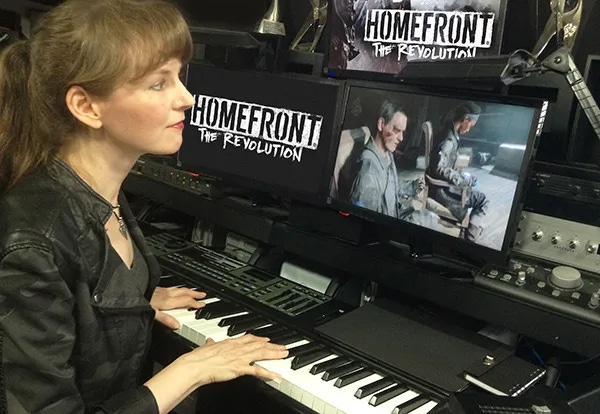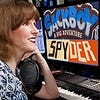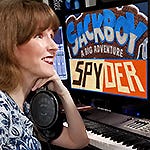
Featured Blog | This community-written post highlights the best of what the game industry has to offer. Read more like it on the Game Developer Blogs or learn how to Submit Your Own Blog Post
Characterization in trailers, cutscenes and cinematics (for the game music composer)
Supporting characterization with linear compositions - 1st in a 4-part series on music for trailers, cutscenes and cinematics, by game composer Winifred Phillips.

By Winifred Phillips | Contact | Follow
Glad you’re here! I’m video game composer Winifred Phillips– thanks for joining us! As we all know, dynamic music has become a central focus of our craft as game composers. In our past articles here, we tend to focus on the awesome power of dynamic implementation to increase the utility of game music across lengthy gameplay sequences. In-game music serves many purposes, so it must morph and change in order to best accommodate shifting circumstances. However, no matter how interactive our in-game tracks may be, we inevitably run into situations in which dynamic music systems fall short.
So today, we’ll be talking about those conditions in which only a linear approach will suffice. We’ll be looking at trailers – linear visual presentations that players experience outside of the context of the game. We’ll also be considering cinematics and cutscenes, in which linear visual content is presented within the game itself. Here’s how I described cinematics and cutscenes in my book, A Composer’s Guide to Game Music:

“Most of our work in video game music creation will be concerned with forms and structures that bear little similarity to the traditional composition undertaken by our counterparts in the fields of television and film. Cinematics and cut scenes, however, are very similar to scenes from a movie or television show, and thus offer us the chance to compose in a more conventional manner. We should seize these opportunities.
“Both cinematics and cut scenes are devoted solely to advancing the narrative. Because they traditionally happen in a fixed sequence that plays out on a set timetable, they can usually be scored just as a film is scored. Certain musical effects can be achieved only through traditional means, and the cinematic and cut scene track allows us the chance to employ them.” Chapter 10, pg. 182
Creating music for a trailer, cinematic or cutscene is commonly referred to as “scoring-to-picture,” since the music is designed to sync directly with a series of events that doesn’t react to player input. In the case of a trailer or a cinematic, the events are captured on video. This makes the moniker “scoring-to-picture” a very literal one.

As I observed in my book, the composition of such music bears strong similarities to the work of film and television composers. On the surface this might sound like a simple adaptation for us. However, as game composers, we’re essentially built differently. Being a game composer necessitates a creative process and skillset that can be drastically different from the way other media composers work. We’re used to thinking of our music as highly-flexible, capable of instantaneous variation, and structured around a multiplicity of component parts. Because of this, when we move from dynamic techniques into a linear structure we might feel a bit restricted. So let’s tackle this problem from our own unique vantage-point. Since our emphasis during the creative process tends to lean towards goal-oriented outcomes, let’s consider some of the goals that linear music can achieve.

I’m going to be sharing some videos that include my own linear compositions for game trailers, cutscenes and cinematics. I’ve arranged these videos according to a set of four goals:
Characterization
Information
Identity
Narrative
So let’s get started!
Characterization
When I was hired by Deep Silver Dambuster to join the music composition team for Homefront: The Revolution, my task was to focus almost exclusively on the cinematic music of the game. Cinematics take agency completely away from the player in order to represent dramatic moments when critical objectives have been achieved.

The story of Homefront: The Revolution is told through cinematics. The narrative follows a group of rag-tag revolutionaries from an alternate-history in which North Korea has occupied the United States and subjugated its people. It was my job to find musical expression for those cinematic moments in which the efforts of the player had yielded big results. It might be tempting to think of this as an opportunity to musically reward players, much in the way that a success stinger might be triggered during gameplay. While a cinematic is often played as a reward for player progress, the world of Homefront: The Revolution presented such dark consequences for player actions that even successes could feel pretty bleak. The cinematics in Homefront: The Revolution also tended to include intense character development and moments of human angst, affording players an opportunity to identify with both their own character and the non-player characters around them.

In composing the music for the cinematics of Homefront: The Revolution, I concentrated on characterization as my top composition objective. While I definitely wanted to support the kinetics of the on-screen action, my ulterior motive was to convey the confusion and horror happening within the characters’ minds. Here’s an example of a cinematic in which the player character rescues a popular resistance leader who had been captured and tortured by the occupying force. Notice how the music leans towards horror techniques, particularly in the final standoff when the player desperately tries to get the prisoner to recognize him.
As you can see, music can move a cinematic beyond an objective presentation, giving us a view into the characters’ state of mind. Now, for a vastly different approach to the same subject, let’s take a look at a cutscene from one of my VR projects, The Haunted Graveyard.

A cutscene is similar to a cinematic, except that players still have the ability to look around and move somewhat freely. Developed by Holospark, The Haunted Graveyard dropped players into an eerie cemetery filled with ghosts and supernatural creatures, and then challenged players to find a way out before midnight. This VR game was certainly not as dark as Homefront: The Revolution. In fact, The Haunted Graveyard conveyed a cheery spookiness akin to Disney’s famous haunted mansion. That being said, the most compelling element of this virtual reality game was its astonishingly detailed characters (a feat that’s notoriously difficult to achieve in VR). The expert team of developers at Holospark created a game engine able to render believable characters delivering convincing emotional performances, while also allowing the player to roam completely around those characters in virtual reality. Players could view the massively detailed characters from every angle. As a result, the characters in The Haunted Graveyard leapt out as its most compelling feature, so I knew it would be of great importance for my musical score to accentuate those characters as much as possible.

The video below is one of the cutscenes from The Haunted Graveyard. In the cutscene, we meet the Caretaker – a mysterious ghostly figure in an elegant tuxedo. While his manner is suave and detached, he’s clearly something other than human, and his dialogue resonates with portents of doom. In composing for this cutscene, I made sure to give this character a very dramatic musical support, boosting his importance in the narrative and lending his spine-tingling dialogue some added weight and significance.
Now we’ve taken a look at how music can accentuate characters within linear constructs such as cutscenes and cinematics. In the next article of this series, we’ll investigate how music can help players better comprehend the kind of information that these sorts of visual presentations are apt to convey. Until then, thanks for reading!

Winifred Phillips is a BAFTA-nominated video game composer whose latest project is the Jurassic World Primal Ops video game (the official game of the blockbuster movie Jurassic World Dominion). Other recent releases include the hit PlayStation 5 launch title Sackboy: A Big Adventure (soundtrack album now available). Popular music from Phillips’ award-winning Assassin’s Creed Liberation score was featured in the performance repertoire of the Assassin’s Creed Symphony World Tour, which made its Paris debut in 2019 with an 80-piece orchestra and choir. As an accomplished video game composer, Phillips is best known for composing music for games in many of the most famous and popular franchises in gaming: the list includes Assassin’s Creed, God of War, Total War, The Sims, and Sackboy / LittleBigPlanet. Phillips’ has received numerous awards, including an Interactive Achievement Award / D.I.C.E. Award from the Academy of Interactive Arts and Sciences, six Game Audio Network Guild Awards (including Music of the Year), and three Hollywood Music in Media Awards. She is the author of the award-winning bestseller A COMPOSER’S GUIDE TO GAME MUSIC, published by the MIT Press. As one of the foremost authorities on music for interactive entertainment, Winifred Phillips has given lectures at the Library of Congress in Washington DC, the Society of Composers and Lyricists, the Game Developers Conference, the Audio Engineering Society, and many more. Phillips’ enthusiastic fans showered her with questions during a Reddit Ask-Me-Anything session that went viral, hit the Reddit front page, received 14.9 thousand upvotes, and became one of the most popular gaming AMAs ever hosted on Reddit. An interview with her has been published as a part of the Routledge text, Women’s Music for the Screen: Diverse Narratives in Sound, which collects the viewpoints of the most esteemed female composers in film, television, and games. Follow her on Twitter, Facebook, and Instagram.
Read more about:
Featured BlogsAbout the Author(s)
You May Also Like







.jpeg?width=700&auto=webp&quality=80&disable=upscale)








